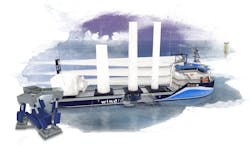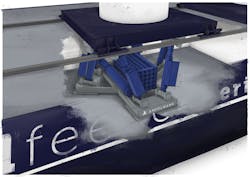Offshore staff
HOOFDDORP, the Netherlands – Ampelmann and C-Job Naval Architects have developed a Jones Act-compliant feeder vessel concept with motion compensation technology to support construction of offshore wind farms in the US.
Todd Allen, VP Business Development at C-Job Naval Architects, said: “The United States is ambitious in its plans to grow the installed offshore wind power. The only viable way to realize this goal while complying with the Jones Act is utilizing offshore wind feeder vessels. Together with our strategic partner Ampelmann… we have created an innovative ship design ready to support construction of US wind farms today and into the future.”
The DP-2 feeder vessel has an L-shaped superstructure that enables the transport of all wind turbine components, including the blades, while keeping the ship itself relatively compact minimizing construction and operational costs. To maximize workability and allow for safe lifting of the components, the feeder vessel features a specially designed motion compensation system by Ampelmann.
The system uses the company’s core technology to stabilize the components of the wind turbine generator (WTG) in six degrees of freedom and is designed for safe lifting operations in sea states up to 2.5 m (8.2 ft) significant wave height. The compensator is positioned close to the vessel’s center where it can compensate all vessel motions and allows for continued operations – even in adverse weather conditions – throughout the year.
The wind turbine components are arranged on the ship with a quick connect grip- and glide system. Cargo pallets are placed on deck thanks to the quick connect system. Once the feeder vessel is at its destination, the system slides the components into place to connect to the motion compensator. The Ampelmann system then compensates all vessel motions, so the crane operator can lift turbine components in a similar fashion to an onshore lift.
The motion compensated wind feeder vessel is designed to provide maximum efficiency and workability during the construction of an offshore wind park, according to C-Job Naval Architects. The installation vessel typically transports the components and then installs the turbines. However, this is an inefficient use of the WTIV, and in the case of foreign vessels not allowed by the Jones Act.
With this feeder concept – which is envisioned to be a series – the turbine components are brought to the installation site by the feeder vessel. With two or more vessels per project, this allows the WTIV to focus on the installation of the turbines and ensures operations can always continue.
Offshore wind feeder specifications are:
- Length overall (approximately): 103.5 m (340 ft)
- Breadth (moulded): 23.8 m (78 ft)
- Depth main deck: 9.2 m (30 ft)
- Draught (design): 5.5 m (18 ft)
- Sailing speed: 13 knots
- Complement: 20 crew + 12 passengers.
04/21/2021




